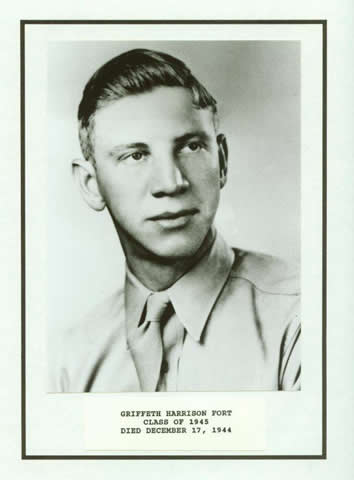GRIFFETH HARRISON FORT, Class of 1945
Born December 3, 1921 to Edwin Hubert and Martha Azalea Thompson Fort in Rogersville, Tennessee. “Griff” as he was known, attended Maryville College, Tennessee for one year before transferring to The Citadel. He enlisted November 4, 1942 in the Army Air Corps.
Torretto Airfield, part of a complex of twenty-four airfields located within 40 kilometers of Foggia, Italy was built and used by the Italian Royal Air Force, seized by the German Luftwaffe, bombed extensively by the USAAF and repaired by the U.S. Army Corps of Engineers, Torretto was home to the 461st and 484th Bomb Groups of the 49th Bomb Wing, 15th Air Force.

Sunday, December 17, 1944, on what was his fifteenth of thirty required missions, Technical Sergeant Fort, and the rest of the crew of 1LT Roger A. Martin piloting B24J #42-51835, “Red 38” took off from Torretto Airfield around 0750 for what would be one of the longest missions for the 15th Air Force. The target for that day was the Synthetic Oil Refinery at Odertal, Germany (present day Zdzieszowice, Poland) some 1500 miles’ round-trip.
At approximately 1150, at an altitude of 25,000 feet, the group was attacked by thirty to forty enemy fighters near Deutsch-Liebau (present day Libinia, Czechoslovakia). Witness accounts report that “Red 38” was attacked by an ME 109 piloted by Lt. Karl Kraft which hit the right wing with 20mm cannon fire. Fire erupted between engines 3 and 4 and the aircraft, with the wing engulfed in flames went into a flat spin and disappeared into the overcast. No parachutes were observed. Kraft’s aircraft was hit by Red 38’s gunners and he was forced to bail out.
The aircraft crashed about two kilometers North East of Deutsch-Leibau. There were no survivors. Fort and his fellow crew members were buried in the local cemetery in Deutsch-Liebau on December 24, 1944.
In August 1945, the frustrated wife of Griff’s bombardier, 2LT Robert G. Sufio, wrote the War Department on behalf of the wives, and parents of the crew, bemoaning the fact that no information as to the status of the crew of “Red 38” had been forthcoming to the families even though the war had been over for four months. On December 18th 1945, one year and a day following the date they were listed as missing in action, the War Department, with no information to the contrary administratively declared Griff and his crew dead. His parents received the news on Christmas Eve 1945.
Following the war, the Graves Registration Service teams scoured the countryside recovering and identifying the dead. Since the crew of Red 38 were deep behind what would be the Iron Curtain it took some time to recover them. In 1946 their remains were recovered and buried in the U.S. Military Cemetery at St. Avold, France. In 1949, in accordance with his family’s wishes, Griff’s remains were returned to the United States for burial in the family plot at McKinney Cemetery in Rogersville, Tennessee.
He was twenty-three years old.
/SSmith


RIP,SiR!!!⚔️🇺🇸⚔️